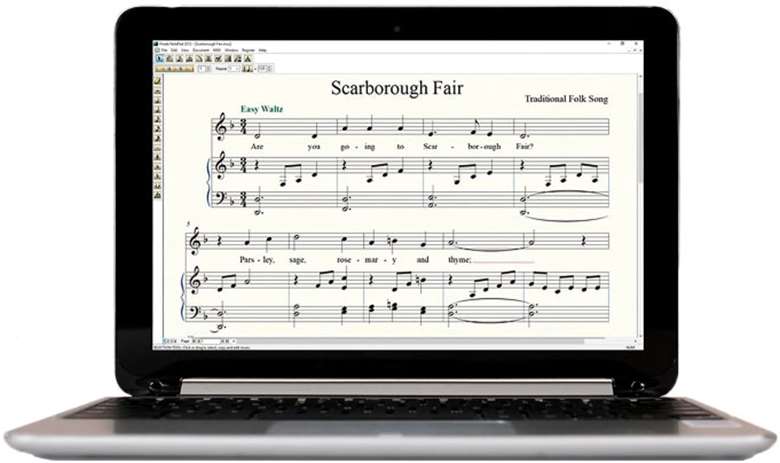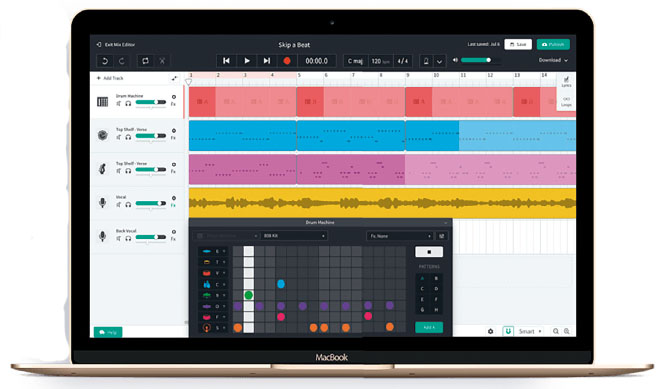Freedom of expression: Free composition software
Tim Hallas
Saturday, May 1, 2021
Composition in schools often requires large amounts of software. This can be tricky, particularly for departments with little to no budget or during times of remote learning. MT's technology editor Tim Hallas takes us through some of the free options available.

Composition is a big part the curriculum at all key stages, but particularly from KS3 and above when it becomes a crucial element of students’ music projects. Consequentially, it features as an essential part of the KS4 and KS5 assessments and is one of the key components of GCSEs and A Levels.
I know from personal experience that composition has been extremely difficult to encourage and engage with over the last year. I have tried all sorts of different solutions to enable my students to develop their composition skills during the assorted lockdowns, including the use of free software to install at home.
Score writing
Students, particularly at KS4 and 5, commonly use score writing software to hand in compositions using traditional notation. This software allows students to create their composition however they see fi t and then transcribe the resulting music to make it presentable and visible to others.
Fortunately, for students working at home, there are now several free pieces of software that can be downloaded, including Dorico SE, Finale Notepad, Sibelius First, NoteFlight and MuseScore.
The first three of these are developed by manufacturers of full score writing/engraving software. These companies have released free versions of their software as a stepping-stone to encourage users to utilise the platform, learn the software and then upgrade to more complete versions when the need arises.
They each offer slightly different features. For instance, Dorico SE only allows users to create scores with two staves, but can open complete scores to view if needed, Finale Notepad allows up to eight staves, and Sibelius First allows up to four. However, they all limit other software features, including the musical elements available.
These are great options for students to use at home if their school or college has the full version of a piece of software. For instance, if a school has the full version of Dorico, a student can work on SE at home, email the finished work to themselves or their teacher to continue working on at school and access the more complete set of features. Equally, a teacher can create an arrangement of a piece of music for an ensemble, send it to their students to open at home and print out their own part for individual practice.
Noteflight is an online platform that runs in any browser, so is particularly suitable for students who might only have access to a Chromebook or a tablet. It doesn't require software to be downloaded or installed and everything is stored in the cloud. That way, work is instantly available wherever a student is working. Unlike some of its competitors, Noteflight limits the number of scores one can create in the free version before the purchase of the premium version.
MuseScore is different again in that it has no paid model at all. It is something called ‘open-source software’. This means that it is developed by a community of users, for that community, at no cost. People do it for the love of coding and software and the shared resource is made available to the public. MuseScore requires downloading and installing onto computers but is cross-platform and will run on a wide range of devices.
MuseScore is a fully functioning score editor and has appropriate engraving controls to create presentable scores. The software is very well equipped and contains a lot of features that other free software does not, but it is slightly less user friendly and has a steeper learning curve due to its many functions. However, there is a wide user base, and many users post to forums to share tips, tricks, and solutions to problems. Obviously, being open source, it doesn't have the big company behind the scenes if there are any technical issues, so fixes and updates might take a while to happen.
DAWs

BandLab is a DAW that runs in a browser
The world of free DAWs is slightly less crowded than that of score writing software, but there are still options available for those with no budget or students working at home. The most common choices are Soundtrap, BandLab, Waveform, Ableton Live Lite, Cubase LE and ProTools First.
The first two run within the browser of any computer (although not all browsers are supported) and therefore the software doesn't need to be installed. As with Noteflight, this is incredibly useful for students who have less powerful computers or are relying on phones and tablets. Both BandLab and Soundtrap have standalone apps for mobile devices (see MT April for a review of BandLab's app) that allow students to work on their mobile devices and then open the same project within a browser at school or college and continue working.
Soundtrap has been featured in Music Teacher several times and offers many great educational resources to help students create music. BandLab is based on the combined technology of Cakewalk and Sonar, and its new owners have made it entirely free. The software is very simple to use and the speed at which it can operate remotely over the internet is extremely impressive.
Waveform is a free DAW that has to be downloaded. The free version, as with most pieces of software in this price bracket, is limited. The number of effects, tracks and included sounds is vastly reduced from the premium version – but this is also true of Soundtrap and the free versions from the bigger manufacturers. However, what I have found interesting is that Waveform offers a completely free premium licence to education users. I have yet to test this out, but I intend to do a full review soon.
Most of the big DAW manufacturers offer a free, entry-level version of their software. A lot of these, such as Cubase LE and Ableton Live Lite, are included with the purchase of some hardware. If you or your school invest in a new set of audio interfaces or keyboards, it's likely that at least one of these will include a licence for the free version of a major DAW.
These free versions are severely limited and offer a restricted track count, few effects and a very small number of included sounds. However, they all offer excellent upgrade options to more feature-rich versions of the software. For instance, the upgrade for Cubase LE to Cubase Elements is only £42 (inc. VAT), so there is a really easy progression route to allow users to try free versions and upgrade as needed.
There are also other pieces of free music creation software that work well but require specific hardware. GarageBand for example (which is essentially a cut-down version of Logic) is free on all Macs and iOS devices – but requires the investment in relevant hardware.
Compromise needed
No matter what style of composition students are creating, it is likely that it will make use of technology in some form. A string quartet will still be more presentable when fed into some score writing/engraving software, a rock band recorded will sound better when recorded via DAW and processed, and an electronic piece of music will probably need software synths.
There are lots of free pieces of software available that can help students realise their compositional vision. However, there is always some level of compromise. Most of these examples either have limited feature sets and encourage their users to upgrade to paid versions, or are limited in other capacities.
However, for schools that don't know whether more lockdowns are imminent, the option to have free software for remote students is hugely beneficial. Even if – and hopefully this is the case – we don't go into lockdown again, the opportunity to have compatible pieces of software at both home and school will have enormous benefits. If a student has Dorico SE and GarageBand at home, and the full versions of Dorico and Logic at school, teachers and students can exchange work easily without having to worry about compatibility issues.
Obviously with free software, you get what you pay for. But that shouldn't matter in the vast majority of cases – particularly for more basic school-based compositions in earlier years. There will be a free piece of software guaranteed to suit your students’ needs, and there will always be an upgrade route if the included features become too limiting.

